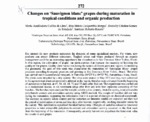Use este identificador para citar ou linkar para este item:
http://www.alice.cnptia.embrapa.br/alice/handle/doc/961835Registro completo de metadados
| Campo DC | Valor | Idioma |
|---|---|---|
| dc.contributor.author | LIMA, M. A. C. de | pt_BR |
| dc.contributor.author | BORGES, R. M. E. | pt_BR |
| dc.contributor.author | TRINDADE, D. C. G. da | pt_BR |
| dc.contributor.author | ROSATTI, S. R. | pt_BR |
| dc.date.accessioned | 2015-12-30T03:51:54Z | - |
| dc.date.available | 2015-12-30T03:51:54Z | - |
| dc.date.created | 2013-07-11 | pt_BR |
| dc.date.issued | 2013 | pt_BR |
| dc.identifier.citation | In: INTERNATIONAL SYMPOSIUM ON GRAPEVINE PHYSIOLOGY AND BIOTECHNOLOGY, 9., 2013, La Serena. Book of abstracts... La Serena, Chile: INIA: ISHS, 2013. | pt_BR |
| dc.identifier.uri | http://www.alice.cnptia.embrapa.br/alice/handle/doc/961835 | pt_BR |
| dc.description | The interest for new products represents the dynamic of some specialized markets. For wines, new products can attract different consumers. Tropical wines and wines produced through an organic management could be an interesting opportunity for viticulturists in São Francisco River Valley, Brazil. In this region, the cultivation of grapes has particularities that increase the necessity of knowing the quality ofthe grapes. Quality show variations during the season, different years and regions. Considering this panorama, the goal of this work was characterize the maturation of 'Sauvignon Blanc' grapes produced according to organic practices and growing in São Francisco River Valley, Brazil. The study was carried out in a commercial vineyard, in Petrolina (09°23' S e 40°30' W), Pernambuco State, Brazil. The plants were irrigated by a drip system. The vines were pruned in May 20 l l and they were submitted to the agronomical practices commonly adopted in the region. Bunches were collected from the beginning ofmaturation to harvest, at 47,54,61,68,71 and 75 days after fruit set. The experiment was carried out as a randomized blocks, in six treatments (days after fruit set) with four replicates consisting of tive bunches. The bunches were analyzed for weight, soluble solids content, titratable acidity, total extractable polyphenols content and antioxidant activity using ABTS method. The weight of bunches did not vary during the maturation, supporting the information that it is a period of changes on chemical compounds. The increase on soluble solids content and the reduction on titratable acidity are expected and they had the period of stabilization at seven and four days after harvest, respectively, reaching desirable values for the variety. This stabilization signalized the ideal harvest time. Changes on variables related to functional properties as total extractable polyphenols content and antioxidant activity occurred on the first week from the beginning of the maturation. Consequently, an early harvest not prejudices the functional value but results in acid grapes. | eng |
| dc.language.iso | eng | eng |
| dc.rights | openAccess | eng |
| dc.subject | Grape | pt_BR |
| dc.title | Changes on Sauvignon blanc grapes during maturation in tropical conditions and organic production. | pt_BR |
| dc.type | Resumo em anais e proceedings | pt_BR |
| dc.date.updated | 2018-04-18T11:11:11Z | pt_BR |
| dc.subject.thesagro | Uva | pt_BR |
| dc.subject.thesagro | Maturação | pt_BR |
| dc.subject.thesagro | Produção Orgânica | pt_BR |
| dc.subject.thesagro | Vitis Vinifera | pt_BR |
| dc.subject.nalthesaurus | Grapes | pt_BR |
| dc.format.extent2 | p. 186. | pt_BR |
| riaa.ainfo.id | 961835 | pt_BR |
| riaa.ainfo.lastupdate | 2018-04-18 -03:00:00 | pt_BR |
| dc.contributor.institution | MARIA AUXILIADORA COELHO DE LIMA, CPATSA; RITA MERCIA ESTIGARRIBIA BORGES FAUSTINO, CPATSA; DANIELLY CRISTINA GOMES DA TRINDADE, CPATSA; SORMANI ROBERTO ROSATTI. | pt_BR |
| Aparece nas coleções: | Resumo em anais de congresso (CPATSA)  | |
Arquivos associados a este item:
| Arquivo | Descrição | Tamanho | Formato | |
|---|---|---|---|---|
| ID50442.pdf | 370,15 kB | Adobe PDF |  Visualizar/Abrir |









